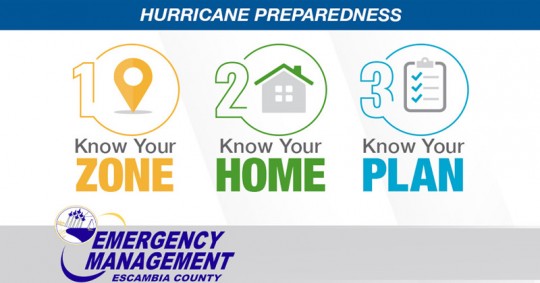Preparing For Tropical Weather: Here Are Tips From Escambia County
August 22, 2020
Escambia County is encouraging residents to closely monitor Tropical Storm Laura and Tropical Storm Marco this weekend and take needed precautions. The National Weather Service of Mobile is forecasting local impacts from Tropical Storm Laura to include heavy rainfall, flash flooding, potentially damaging straight line winds, possible tornadoes, large hail, high risk of rip currents and high surf.
While it is still too soon to know the exact paths or forecasts for the storms, Escambia County is planning for the worst case scenario.
“Residents still have plenty of time to ensure they are able to get their storm preparations in place,” Emergency Manager Eric Gilmore said. “Use the weekend to make sure you have a storm kit ready, secure any yard or porch debris, and replace an old batteries in those flashlights and radios.”
Gilmore noted there is still uncertainty in the storm’s forecast, but staff will be diligently monitoring the weather over the next 48 hours and will be prepared to declare a local state of emergency if needed.
Residents are encouraged to prepare their disaster kits now, which should include seven days of food and water supplies for after the storm arrives. Residents are also encouraged to fuel all vehicles and generators, and prepare all medications needed by family and pets. Individuals should also consider having at least two emergency supply kits, one full kit at home and smaller portable kits in their workplace, vehicle or other places they spend time. Remember, this year’s disaster kit might need to look a little different if you’re planning to go to a shelter—make sure to include face coverings, hand sanitizer and disinfecting wipes.
The Escambia County Public Works Department has made sand available at several locations. Click or tap here for a list.
Tips to Prepare for a Storm
Know Your Zone – Go to BeReadyEscambia.com to find out which evacuation zone you are in. Sign up for alerts on BeReadyEscambia.com.
Know Your Home – Is it newly built – possibly rated for a hurricane? Your safest place may be at home rather than a shelter due to COVID-19. Shelters will be announced later and will have masks and hand sanitizer.
Know Your Plan – plan ahead to stay with loved ones, friends or stay at a hotel away from the area
Follow these tips to stay safe during severe weather:
- Pay extra attention to local weather reports until the storm has moved through the area. Be sure to keep your weather radio on and your cell phone charged to ensure you can receive weather alerts.
- With the possibility of high winds, it is recommended that any lightweight outside furniture or equipment be secured before Wednesday morning.
- Organizations with planned outside activities during this Enhanced Risk period need to be weather aware and take the appropriate actions.
Tornado safety tips from the National Weather Service:
- GET IN – If you are outside, get inside. If you’re already inside, get as far into the middle of the building as possible.
- GET DOWN – Get underground if possible. If you cannot, go to the lowest floor possible.
- COVER UP – Flying and falling debris are a storm’s number one killer. Use pillows, blankets, coats, helmets, etc to cover up and protect your head and body from flying debris.
- An extensive list of tornado safety tips and scenarios is available at weather.gov/ama/severesafetytips.
Tips to maintain COVID-19 best practices while sheltering during severe weather:
- Keep 6 feet of physical distance between you and others
- Wear a face covering or mask per the Florida Department of Health
- Keep disinfectant wipes and gloves handy
- View more safety tips from the CDC here




Comments